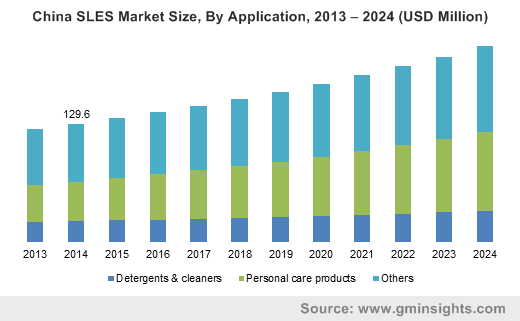APAC Sodium Lauryl Ether Sulfate (SLES) Market to witness phenomenal gains via surging demand from personal care applications over 2016-2024
Publisher : Fractovia | Published Date : 2017-06-22Request Sample
Majorly driven by the rising consumer consciousness regarding personal hygiene, Sodium lauryl ether sulfate (SLES) market is set to grow at a CAGR of 5% over the coming years. A high rate of commercialization of personal care products such as body soaps, lotions, cleansers, shampoos, and conditioners will have a positive influence on the overall sodium lauryl ether sulfate industry. Major companies have recognized the shifting trends of consumers toward hygiene and cleanliness, and have accordingly expanded their product portfolio to target a wider customer base. In addition, sodium lauryl ether sulfate market participants concentrate on increasing the number of research and development activities in order to come up with an impressive range of innovative products. For instance, BASF had established a R&D facility in India and had formed alliances with many universities in Asia to strengthen their business position. For that matter, the year 2014 had even witnessed Stepan Company launching an R&D facility in Brazil to strengthen their surfactants domain.
SLES market is quite fragmented and encompasses the participation of several renowned biggies. Major players operating in this business include BASF, Dow Chemical Company, Croda International, Ho Tung Chemical, Huntsman Corporation, Clariant Corporation, Zhejiang Zanyu Technology, Stepan Company, Ultra Group, Evonik Industries, Solvay, Taiwan NJC Corporation, Galaxy Surfactants, Kao Corporation, and Godrej Industries.
China SLES Market Size, By Application, 2013 – 2024 (USD Million)

SLES is also called sodium laureth sulfate, and is an anionic surfactant that is popularly used in detergents. Worldwide demand for household detergents crossed 30 million tons in terms of volume in 2015 and is expected to increase at a rate of 5% over time, pertaining to the numerous government initiatives to maintain cleanliness in public areas such as airports, bus stations, railway stations, etc. In addition, the residential and commercial sectors have been experiencing an increase in the requirement of household detergents, which will spur SLES industry.
While sodium lauryl ether sulfate finds usage in two primary applications, viz., personal care and detergents, it is also extensively used in antimicrobial, agricultural, and medical chemicals. SLES market size from detergents & cleaners was valued for more than USD 450 million in 2015, and is expected to cross USD 650 million by 2024. This growth can be attributed to the fact that this product is compatible with both fat and water and is a wonderful stain remover, making it popular among detergent manufacturers.
The soaring detergent sector in Europe and Asia Pacific will propel sodium lauryl ether sulfate market size. Europe SLES industry was valued for over USD 250 million in 2015 and is likely to register a CAGR of 4.5% over 2016-2024, hitting a valuation of USD 400 million by 2024. This growth can be credited to the high living standards in the European nations and the rising awareness regarding personal hygiene.
Asia Pacific held more than 33% of global SLES market share in 2015 and will grow at a rate of 5% over 2016-2024. The rising consumer purchase parity and the high-grade lifestyles will stimulate the regional growth. China, India, and Japan are slated to be the key revenue pockets.
Personal care products are another chief application arena of SLES industry. This segment held more than 25% of the overall market share in 2015 and is forecast to grow at a CAGR of 6% over 2016-2024, pertaining to rising consumer consciousness regarding personal cleanliness. The lathering and foaming properties of the product will lead to its adoption in creams, soaps, shampoos, lotions, and bath oils, which will spur SLES market from the personal cares sector across various geographies.
Europe SLES industry share from personal care products was more than USD 100 million in 2015. Pertaining to the gradual industrial shift toward East Europe, this regional market will register a high demand for personal care products and detergents.
Global SLES market development is likely to be hindered by a barrage of constraints. A crucial one among the many restraint factors is the fact that sodium lauryl ether sulfate is an infamous eye, lung, and skin irritant that leads to harmful health hazards. In addition, its manufacturing process may lead to the production of carcinogenic substances such as 1,4-dioxane and ethylene oxide. The U.S. EPA and FDA have been keeping a vigilant eye on the manufacturing process of this product, which may hamper SLES industry. However, companies have been trying to develop products that are eco-friendly and bio-based, in addition to researching a safer manufacturing process to develop the product. These efforts may bear fruit and give rise to an exponential growth rate for SLES market over the coming seven years.